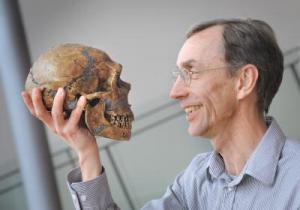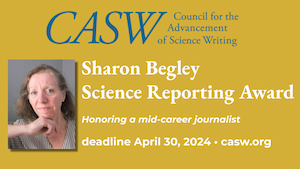GENUS HOMO PART 1: NEANDERTAL GENOME. John Hawks continues the analyses he and his student colleagues have been carrying out comparing the Nandertal genome sequence to genomes from several contemporary human populations drawn from the enormous catalog of human genetic variation known as the 1000 Genomes Project. The Neandertal sequence is based on fossils dated to about 38K bp from Vindija Cave in Croatia, an especially rich site for layered Homo fossils from several time periods.
As you might expect, given the constraints of geography on the human appetite for sexual novelty throughout most of our history, today's populations vary in their proportion of Neandertal genes. For example, Europeans possess a bit more Neandertal DNA than Asians do. That may mean, Hawks speculates, that after the original miscegenation took place, modern humans miscegenated again as they were moving into Europe and encountering the many existing Neandertal enclaves.
Folks from Tuscany, Hawks reports, exhibit the highest proportion of Neandertal genes. Not that it amounts to much, about half a percent more than Brits or Finns. He expects analyses will eventually permit hypotheses about the time(s) and place(s) of coming together. I'm hypothesizing right now: Too cold in Britain and Finland for people to get out much. But in warm romantic Tuscany, sexual adventure has been in the air for tens of thousands of years! That should be good for tourism.
Dienekes Pontikos's speculations on this point at Dienekes' Anthropology Blog are much less Hollywood than mine. Not to mention far more informed. See also his recent post "Archaic DNA data mining for dummies." It's a helpful short primer.
THE GENUS HOMO PART 2: DENISOVAN GENOME. Svante Pääbo and his ancient DNA team at the Max Planck Institute for Evolutionary Anthropology have completed sequencing DNA from that new close relative of ours, the not-Neandertal found in 2008 at Denisova cave in southern Siberia.
The important news about this news — unprecedented, really — is that they've made the sequence public and available even though they haven't published the paper on it yet. John Timmer explains at Ars Technica. The DNA is from a bit of finger bone dated to about 30K bp. Here's how to obtain the data. In addition, Dienekes waxed rapturous — and prescriptive.
Let this be a lesson to all those who have been sitting on important data (*cough* Otzi's genome) for more than a year.
THE SUSAN G. KOMEN-PLANNED PARENTHOOD THING IS STILL ALIVE AND KICKING BUTT. Jumping forward tens of thousands of years to the sorry tale that began last week, Karen Handel, Komen vice-president for policy, has "resigned." Handel is the failed Georgia gubernatorial candidate, a long-time critic of Planned Parenthood, who joined Komen last year--and has been heavily rumored to be the driving force behind the charity's original decision to stop giving grants to PP. Among others, Katherine Hobson reports at the Wall Street Journal's Health Blog.
Throwing Handel under the bus seems to me the most intriguing development so far. It means that Komen has decided that its future, if any, does not lie with those who want to restrict women's procreative behavior. It's a calculation that makes me quite cheerful, considering that Komen founder and chief executive Nancy Brinker has been involved with — and most generous to — Republican politicians in the past.
A former Komen board member says Brinker should resign too, and so should the current board. Jeannine Stein reports for Booster Shots. At Wonkblog, Sarah Kliff traces Komen's original decision process, pointing out that two internal committees recommended last year that Komen not stop funding PP.
The worst thing about Komen, says Christie Aschwanden at Last Word on Nothing, is its espousal of
the notion that breast cancer is a uniformly progressive disease that starts small and only grows and spreads if you don’t stop it in time[, which] is flat out wrong.
As a result, Komen is a big advocate for screening, especially mammography. You'll recall that one of its serial excuses for shutting off money to Planned Parenthood was that PP did mammography referrals only, not the procedure itself. Aschwanden says
Right now, breast cancer screening sucks. It’s not very effective, and if you measure it solely based on the number of lives saved versus healthy people unnecessarily subjected to cancer treatments, it seems to cause more harm than good.
LINKUPS, 2012 WEEK 6. So many intriguing posts, so little time.
Not unrelated to the Komen affray: The Great Contraception Battle of 2012. Andrew Sullivan collects commentary on whether all employer health plans should offer free contraception. He puts the most intriguing data up front, which are that white evangelicals are far more opposed (56%) than are Catholics (37%.) Making it suddenly clear why the Obamans are risking backing that plan. That makes me cheerful, too.
Speaking of biological anthropology, as we were up top, biological anthropologist Kristina Killgrove, blogging at Powered by Osteons, has a 2-part series on the history of bioarchaeology in the Americas and Italy, with the emphasis on ethical issues.
Visualizing the Connected Brain. Lovely, but at the scale reproduced here on the left, not very intelligible. Neuroskeptic explains what you're seeing, noting that the brain is not made of soup, but it's not made of spaghetti either.
Read all 191 pages of Steve Jobs’ FBI file. Jolie O'Dell at VentureBeat.
Not a blog, but if you write about matters medical, know that NIH has launched a new site to explain clinical trials to the public. Here also is the press release explaining what the site will explain.
Lunch break: Hipsters of the future. At Wonkblog, Sarah Kliff brings us the funniest video of the week, looking back at today's social media from 50 years in the future.
Also at Wonkblog, Suzy Khimm reports on a new paper showing that American attitudes toward climate change have been most strongly influenced by the partisan political debates about it.
Not so funny. A minute's worth of clips from the Mount Etna eruption of Feb 8-9, courtesy of the BBC.
The Scale of the Universe. If you look at nothing else this week — or this year--look at this. And tremble. Thanks to Jason Kottke for the link. And to Cary Huang and Michael Huang for doing it.

.png)

